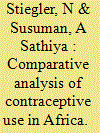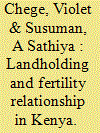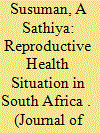|
|
|
Sort Order |
|
|
|
Items / Page
|
|
|
|
|
|
|
| Srl | Item |
| 1 |
ID:
147326


|
|
|
|
|
| Summary/Abstract |
The aim of this article is to show a comparative analysis of contraceptive use in areas of traditionally high fertility that have gone through profound changes. Data have been taken from the latest Demographic and Health Surveys (DHS). Logistic regression models were adopted for four selected representative countries, namely Egypt, Mali, Namibia and Niger. There were two selection criteria: data should be recent, and selected countries should have high (Egypt 57.4%; Namibia 46.4%) or low (Mali 7.5%; Niger 10.0%) contraceptive use. The probability of using contraception when a woman has had one to four children is 2.4 times higher than when they have had no children. Contraception data are always gathered at a point of time, but cross-sectional data are not sufficient to understand all the mechanisms hidden behind contraceptive use. Different contraceptive behaviours need good estimation tools to develop specific family planning programmes.
|
|
|
|
|
|
|
|
|
|
|
|
|
|
|
|
| 2 |
ID:
149485


|
|
|
|
|
| Summary/Abstract |
A few key factors affecting usage of all methods and contraceptive discontinuation among women whom are currently married in Ethiopia are discussed. What are the factors affecting women’s contraceptive use? The aim is to explore the two regions on the basis of high total fertility rate (TFR) regions (Oromiya (5.6) and Southern Nations, Nationalities, and People’s Region (SNNPR) (4.9)) in the Ethiopian demographic and health survey (EDHS) 2011. A descriptive and comparative study using the quantitative research method is chosen to address the above research question. The study findings show that the contraceptive discontinuation rate for users of all types of methods is 37%. The highest women’s discontinuation rate is for the pill which is 70% due to side effects.
|
|
|
|
|
|
|
|
|
|
|
|
|
|
|
|
| 3 |
ID:
157780


|
|
|
|
|
| Summary/Abstract |
Many studies have looked into domestic violence but very few have considered women’s knowledge and perception about their rights. This study aims to examine the main sociocultural factors behind domestic violence against women with an emphasis on the power of the knowledge and perception of the women about their international and constitutional rights. Quantitative data collected in 2015 in the regions of East and Southwest Burkina Faso is used in this paper. Multivariate logistic regression is implemented to take into consideration the net effects of each factor when controlling the effects of other covariates. Results of this paper can be used to implement actions against domestic violence in the zone of intervention of the Program of Sexual Health and Human Rights project.
|
|
|
|
|
|
|
|
|
|
|
|
|
|
|
|
| 4 |
ID:
143333


|
|
|
|
|
| Summary/Abstract |
The recent female literacy and fertility levels in Kerala state are examined using the 2011 census data. Arriaga’s approach for estimation of age-specific fertility rates is undertaken to show the particularities of Kerala state and the best practices which made this state an example for other states in India as well as other places in the world, particularly developing countries. Women’s empowerment gets as much credit as physical facilities and family planning programs; this empowerment level of women is also related to their level of education.
|
|
|
|
|
|
|
|
|
|
|
|
|
|
|
|
| 5 |
ID:
140120


|
|
|
|
|
| Summary/Abstract |
Tanzania’s child mortality rate—between 103 and 130 deaths per 1000 live births–is well above the world average. The data from the Tanzania HIV/AIDS and Malaria Indicator Survey 2007/08 were used in order. There were 27,511 children included in the analysis. Regression analysis focused on child mortality based on maternal and fertility behaviours. Children belonging to the group of higher birth order faced 0.17 odds of dying. A birth spacing of 24 months or longer was observed in the successive birth interval for 76% of the respondents. Focusing on the study’s findings, encouraging longer breastfeeding practice is one way to help produce a healthy baby.
|
|
|
|
|
|
|
|
|
|
|
|
|
|
|
|
| 6 |
ID:
143334


|
|
|
|
|
| Summary/Abstract |
The aim of study was to address the factors influencing landholdings and fertility among women in rural Kenya. The data used are from the 2008–2009 Kenya Demographic and Health Survey (KDHS) of a representative sample size of 6761 women, aged 15–49 years. Statistical tests are utilized to answer the research question, such as Chi-square and logistic regression and P-tests. The results show that the relationship between fertility and landholdings influences family sizes. The relationship between fertility behaviour and occupational status is found to be statistically significant with a P-value of 0.00 and χ2 of 268.24. A high proportion (68.9%) of the women had worked in the preceding reference period. The result of this study is expected to be of particular use for policy makers, planners and other interested stakeholders in population and development spheres.
|
|
|
|
|
|
|
|
|
|
|
|
|
|
|
|
| 7 |
ID:
160819


|
|
|
|
|
| Summary/Abstract |
Fertility is one of the elements in population dynamics that makes a significant contribution towards changing population size and structure over time. In Ethiopia, for the last 10 years the total fertility rate (TFR) has declined slightly from 5.5 to 4.8 children in 2011. But, the TFR in urban areas has increased from 2.4 to 2.6 per 1000 live births. The Bongaarts model was applied to estimate the indices of the four main proximate determinants of fertility. Bongaarts defines the TFR of a population as a function of the total fecundity rate (TF), index of marriage (Cm), index of contraception (Cc), index of postpartum infecundability (Ci), and index of abortion (Ca); this can be written as TFR = Cm × Cc × Ci × Ca × TF. In 2005, the index of married women in urban areas was lower than rural, but it was unfortunately the same in urban and rural areas in 2011. For the last decade, the index of postpartum infecundability had a great fertility reduction effect compared with the contraception index and marriage index in rural Ethiopia. The lower the four indices of proximate determinants, the more fertility will be reduced. As such, the Ethiopian government, international non-governmental organizations and policy-makers must pay attention to increase the prevalence of contraceptive use and educate society to fight against child marriage. Permanent contraceptive use, such as female sterilization, should be promoted; moreover, legal organizations and the community must work together to raise the legal age of marriage to 18 years.
|
|
|
|
|
|
|
|
|
|
|
|
|
|
|
|
| 8 |
ID:
162420


|
|
|
|
|
| Summary/Abstract |
South Africa is still lagging behind with health outcomes, especially when it comes to accessing treatment, prevention and care for reproductive health issues despite the significant progress made with regard to certain aspects of the health system. This study explores the reproductive health situation in South Africa. The study explores some selected health outcomes and related policies from the nine provinces in South Africa. The results indicate that, despite the progress made in the fight against HIV/AIDs and other health-related problems, little has been done to improve maternal health care.
|
|
|
|
|
|
|
|
|
|
|
|
|
|
|
|
| 9 |
ID:
134241


|
|
|
|
|
| Summary/Abstract |
The problem of disabilities is growing all over the world. Nevertheless, some progress has been made since the year 1981 was proclaimed International Year of Disabled Persons. In 2001 people living with disabilities accounted for 5% of the South African population. Because of their disabilities or the perception society has regarding their potential, this population is mostly economically inactive. This study assesses the relationship between disabilities and the adverse socio-economic impacts. Both descriptive and logistics regression models are used to understand the problem by exploring the data of the 2006 South African General Household Survey. The overall people living with disabilities and aged 15–49 years is estimated at 1742 (961 males and 780 females), when exploring people with disabilities findings reveal that the Western Cape Province’s disabled are mostly affected by physical disabilities (40%). People living with disabilities are 3.5 times (p < 0.01) more likely to suffer from illness/injuries (flu, tuberculosis (TB) and severe cough, diarrhea, blood pressure and HIV/AIDS) than others. Therefore, the study aims to contribute to a better condition of people living with disabilities in South Africa by informing and possibly changing the public perception about them.
|
|
|
|
|
|
|
|
|
|
|
|
|
|
|
|
| 10 |
ID:
123273


|
|
|
|
|
| Publication |
2013.
|
| Summary/Abstract |
Child mortality in Sierra Leone is the highest ranked in the world. The main causes for child mortality are maternal factors, environmental factors and health factors. Minimal research has been carried out on health factors in Sierra Leone. The objective of this study is to see how maternal and environmental factors have an effect on health factors, which in turn cause child mortality. The data used were from the 2008 Sierra Leone Demographic and Household Survey (SLDHS). The study showed that child mortality had statistically significant factors associated with it: place of residence, birth number, religion and type of toilet facility. Furthermore, the SLDHS had not given much information regarding the cause of diseases affecting children, so we looked only at the effects they had on children. Acute respiratory infections, diarrhoea and measles each had one variable that was statistically significant. As for pneumonia, there were no variables associated with children contracting the disease.
|
|
|
|
|
|
|
|
|
|
|
|
|
|
|
|
| 11 |
ID:
142509


|
|
|
|
|
| Summary/Abstract |
The aim of this paper is to determine and compare the risk factors of maternal mortality before and after childbirth in Burkina Faso. Analyses are performed at both bivariate and multivariate level using conditional logistic regression. An Emergency Obstetric Care (EMOC) survey of Burkina Faso for 2010 provided the data utilized for the analyses. The diagnosis of health professionals indicated that abortion with 36.3% is the main direct cause of prenatal maternal deaths while haemorrhage with 41.6% is the main direct cause of maternal mortality after delivery. In addition, 29.4% of post-natal maternal deaths were due to infection while only 23.5% of prenatal maternal deaths were due to the same cause.
|
|
|
|
|
|
|
|
|
|
|
|
|
|
|
|
|
|
|
|
|